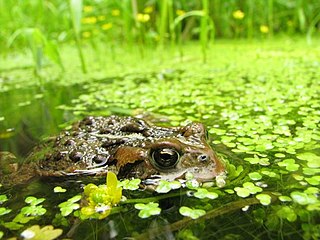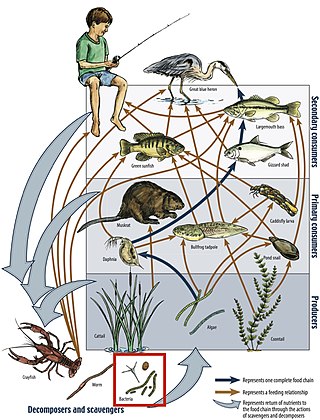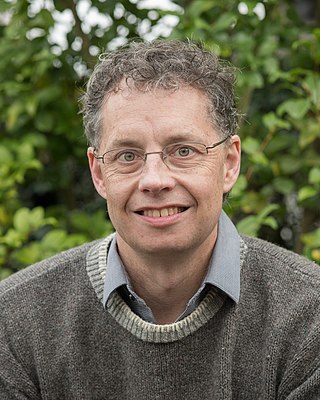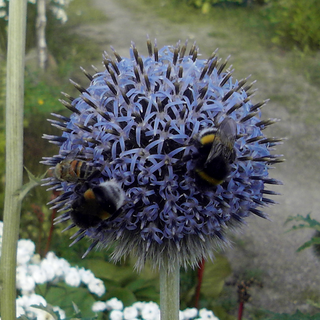
Ecology is the study of the relationships among living organisms, including humans, and their physical environment. Ecology considers organisms at the individual, population, community, ecosystem, and biosphere level. Ecology overlaps with the closely related sciences of biogeography, evolutionary biology, genetics, ethology, and natural history. Ecology is a branch of biology, and it is not synonymous with environmentalism.
A complex system is a system composed of many components which may interact with each other. Examples of complex systems are Earth's global climate, organisms, the human brain, infrastructure such as power grid, transportation or communication systems, complex software and electronic systems, social and economic organizations, an ecosystem, a living cell, and ultimately the entire universe.

A food web is the natural interconnection of food chains and a graphical representation of what-eats-what in an ecological community. Another name for food web is consumer-resource system. Ecologists can broadly lump all life forms into one of two categories based on their trophic levels, the position it occupies in the food web: 1) the autotrophs, and 2) the heterotrophs. To maintain their bodies, grow, develop, and to reproduce, autotrophs produce organic matter from inorganic substances, including both minerals and gases such as carbon dioxide. These chemical reactions require energy, which mainly comes from the Sun and largely by photosynthesis, although a very small amount comes from bioelectrogenesis in wetlands, and mineral electron donors in hydrothermal vents and hot springs. These trophic levels are not binary, but form a gradient that includes complete autotrophs, which obtain their sole source of carbon from the atmosphere, mixotrophs, which are autotrophic organisms that partially obtain organic matter from sources other than the atmosphere, and complete heterotrophs that must feed to obtain organic matter.

Human ecology is an interdisciplinary and transdisciplinary study of the relationship between humans and their natural, social, and built environments. The philosophy and study of human ecology has a diffuse history with advancements in ecology, geography, sociology, psychology, anthropology, zoology, epidemiology, public health, and home economics, among others.

In ecology, a biological interaction is the effect that a pair of organisms living together in a community have on each other. They can be either of the same species, or of different species. These effects may be short-term, or long-term, both often strongly influence the adaptation and evolution of the species involved. Biological interactions range from mutualism, beneficial to both partners, to competition, harmful to both partners. Interactions can be direct when physical contact is established or indirect, through intermediaries such as shared resources, territories, ecological services, metabolic waste, toxins or growth inhibitors. This type of relationship can be shown by net effect based on individual effects on both organisms arising out of relationship.
Chemical ecology is the study of chemically mediated interactions between living organisms, and the effects of those interactions on the demography, behavior and ultimately evolution of the organisms involved. It is thus a vast and highly interdisciplinary field. Chemical ecologists seek to identify the specific molecules that function as signals mediating community or ecosystem processes and to understand the evolution of these signals. The substances that serve in such roles are typically small, readily-diffusible organic molecules, but can also include larger molecules and small peptides.

Rino Rappuoli is an Italian immunologist. He is the head of vaccine research and development (R&D) at GlaxoSmithKline (GSK) Vaccines. Previously, he has served as visiting scientist at Rockefeller University and Harvard Medical School and held roles at Sclavo, Vaccine Research and CSO, Chiron Corporation, and Novartis Vaccines.
A coupled human–environment system characterizes the dynamical two-way interactions between human systems and natural systems. This coupling expresses the idea that the evolution of humans and environmental systems may no longer be treated as individual isolated systems. Some examples of coupled systems can be read here in the section "Socioeconomic Drivers":Environmental factor#Socioeconomic Drivers
Soil ecology is the study of the interactions among soil organisms, and between biotic and abiotic aspects of the soil environment. It is particularly concerned with the cycling of nutrients, formation and stabilization of the pore structure, the spread and vitality of pathogens, and the biodiversity of this rich biological community.
Bacteriophages (phages), potentially the most numerous "organisms" on Earth, are the viruses of bacteria. Phage ecology is the study of the interaction of bacteriophages with their environments.

In ecology, a community is a group or association of populations of two or more different species occupying the same geographical area at the same time, also known as a biocoenosis, biotic community, biological community, ecological community, or life assemblage. The term community has a variety of uses. In its simplest form it refers to groups of organisms in a specific place or time, for example, "the fish community of Lake Ontario before industrialization".
An ecological network is a representation of the biotic interactions in an ecosystem, in which species (nodes) are connected by pairwise interactions (links). These interactions can be trophic or symbiotic. Ecological networks are used to describe and compare the structures of real ecosystems, while network models are used to investigate the effects of network structure on properties such as ecosystem stability.

The history of life on Earth is closely associated with environmental change on multiple spatial and temporal scales. Climate change is a long-term change in the average weather patterns that have come to define Earth’s local, regional and global climates. These changes have a broad range of observed effects that are synonymous with the term. Climate change is any significant long term change in the expected pattern, whether due to natural variability or as a result of human activity. Predicting the effects that climate change will have on plant biodiversity can be achieved using various models, however bioclimatic models are most commonly used.

Carl Theodore Bergstrom is a theoretical and evolutionary biologist and a professor at the University of Washington in Seattle, Washington, United States. Bergstrom is a critic of low-quality or misleading scientific research. He is the co-author of a book on misinformation called Calling Bullshit: The Art of Skepticism in a Data-Driven World and teaches a class by the same name at University of Washington.

A pollination network is a bipartite mutualistic network in which plants and pollinators are the nodes, and the pollination interactions form the links between these nodes. The pollination network is bipartite as interactions only exist between two distinct, non-overlapping sets of species, but not within the set: a pollinator can never be pollinated, unlike in a predator-prey network where a predator can be depredated. A pollination network is two-modal, i.e., it includes only links connecting plant and animal communities.
Rodolfo Dirzo is a professor, conservationist, and tropical ecologist. He is a Bing Professor in environmental science at Stanford and a senior fellow at the Stanford Woods Institute for the Environment. His research interests mainly focus on plant-animal interactions, evolutionary ecology, and defaunation in the tropics of Latin America, Africa, and the Central Pacific. He was a member of the Committee on A Conceptual Framework for New K-12 Science Education Standards, co-authoring the framework in 2012, and continues to educate local communities and young people about science and environmental issues.
Phoebe L. Zarnetske is a community ecologist and associate professor at Michigan State University. Her work focuses on the ecological and evolutionary mechanisms that shape natural communities across multiple spatial scales.
Elizabeth T. Borer is an American ecologist and a professor of ecology, Evolution and Behavior in the College of Biological Sciences at the University of Minnesota.
Eco-evolutionary dynamics refers to the reciprocal effects that ecology and evolution have on each other. The effects of ecology on evolutionary processes are commonly observed in studies, but the realization that evolutionary changes can be rapid led to the emergence of eco-evolutionary dynamics. The idea that evolutionary processes can occur quickly and on one timescale with ecological processes led scientists to begin studying the influence evolution has on ecology along with the affects ecology has on evolution. Recent studies have documented eco-evolutionary dynamics and feedback, which is the cyclic interaction between evolution and ecology, in natural and laboratory systems at different levels of biological organization, such as populations, communities, and ecosystems.
Julia Parrish is an ecologist and conservation biologist at the University of Washington known for her research on seabirds and for her leadership in citizen science. She is an elected fellow of the American Association for the Advancement of Science.








